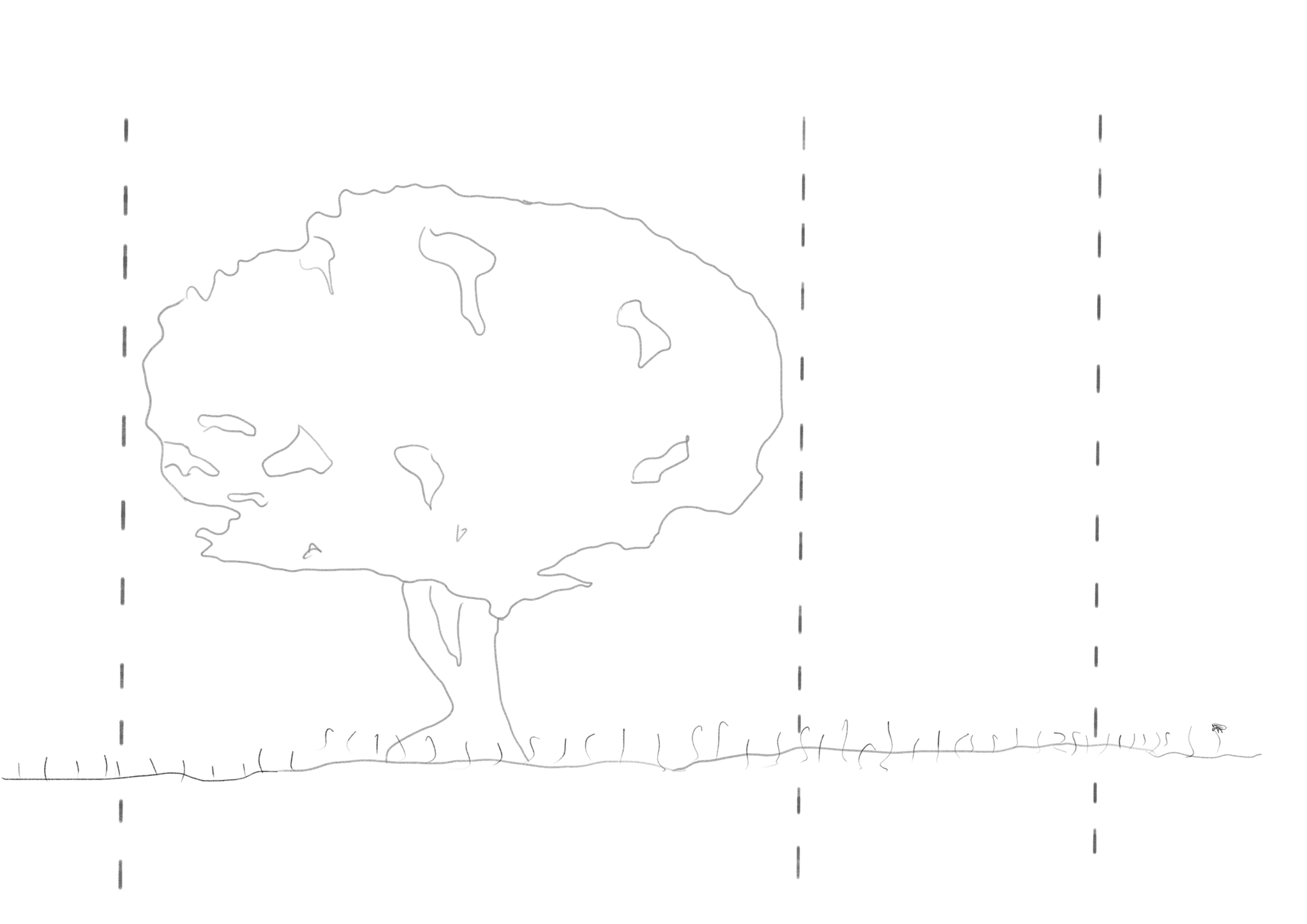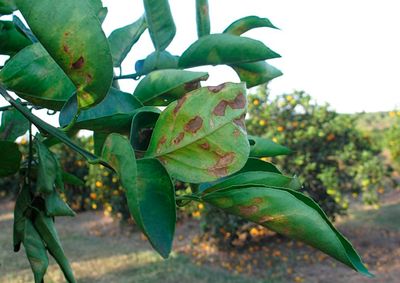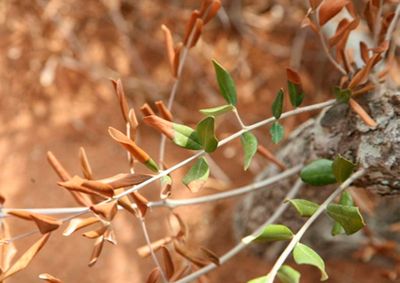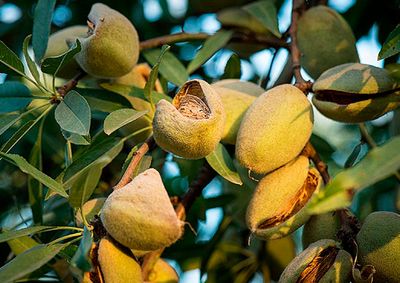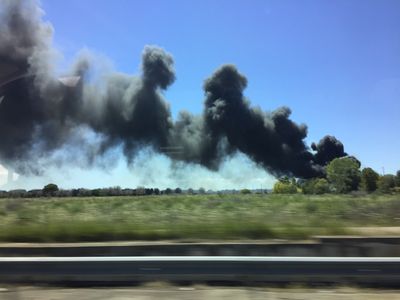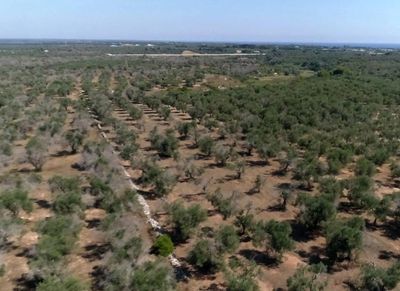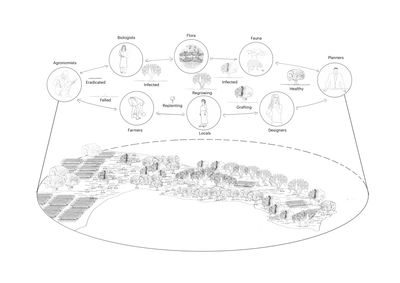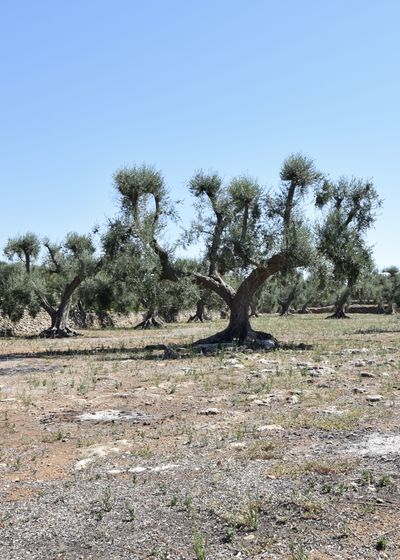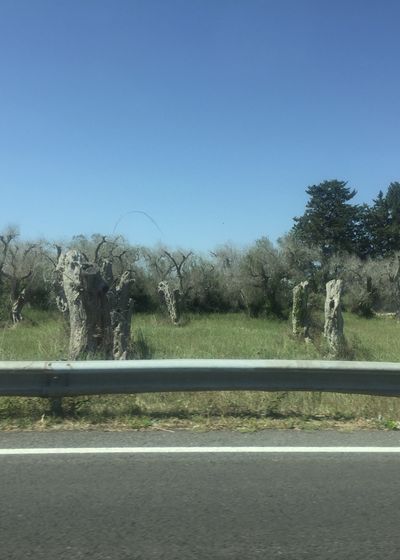Pandemic in the Olive Groves:
The Crisis of Olive Farming in Salento
Annamaria Bonzanigo
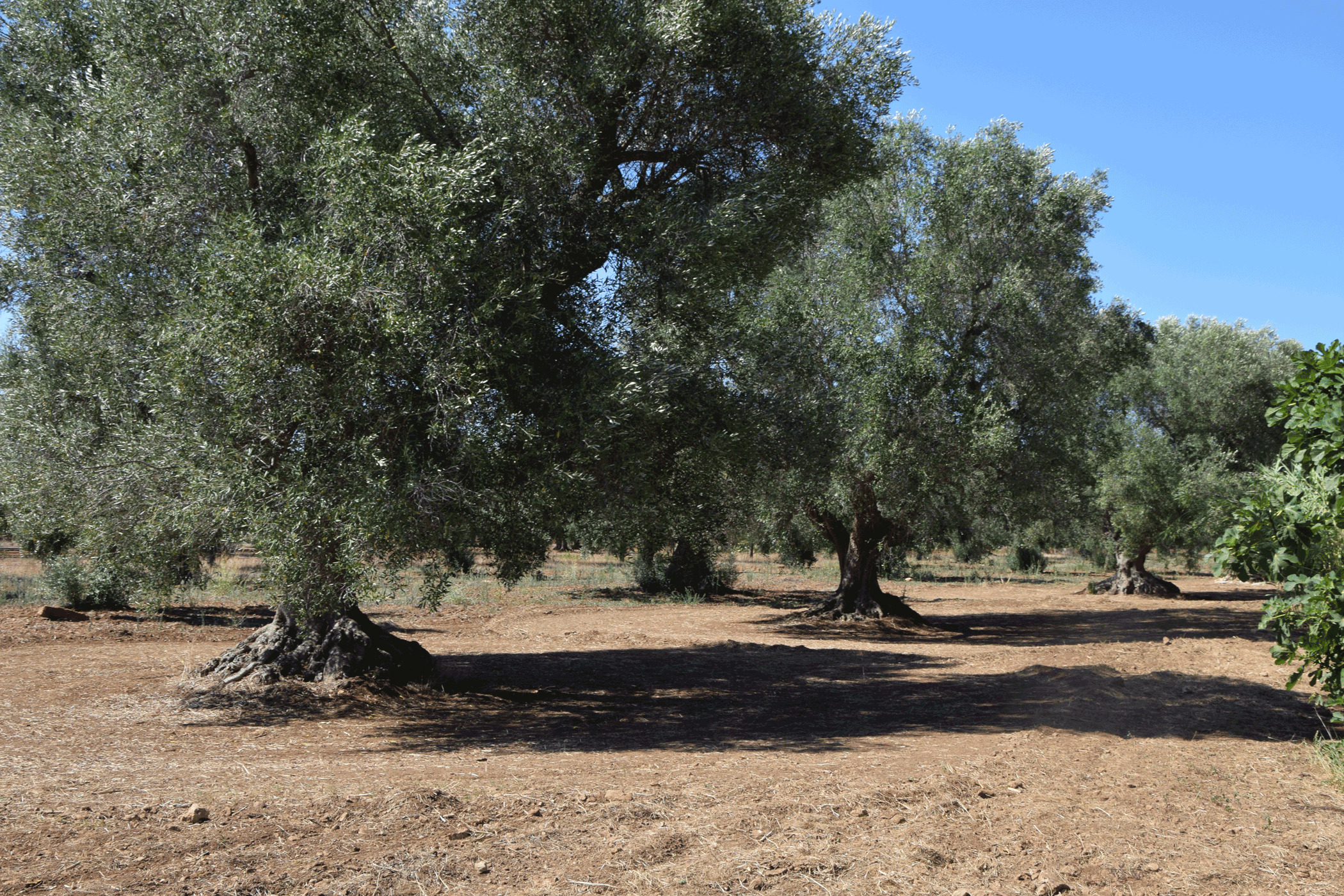
Disease Transmission, PCR tests, Symptoms, Asymptomatic, those are recurrent terms amidst today’s pandemic’s discussion. As the most probable hypothesis for the origins of COVID-19 is a zoonotic pathogen1, we realize that in bad conditions, the proximity of humans and animals can become a source of severe infections. If not detected at its early stages, rapid displacement and expansion becomes ever harder to control, leading to the dismantling of our societies and economies. We entered the “Age of pandemics” where through rising urbanization, intensive farming, globalization of human and animal transport pandemics will inevitably occur more often and spread faster2. Yet global displacement of plant should also critically be considered. Since 2013, a plant pathogenic bacterium named Xylella fastidiosa, reached the European territory, causing the death of many Olive groves. Those olives strongly contributed to the typical agro-ecosystem of the Mediterranean Basin3; many of them were more than 100 years old. Territories, such as Salento, where the disease was first detected, find their ecologies and economies devasted, giving way to property and soil speculations. Xylella fastidiosa can not only be considered a disease affecting plants but should also be understood as a territorial and urbanistic threat. If we do not urgently start to rethink the value given to the work of the land and the way we practice agriculture today we will soon lose all our natural ecologies of strong cultural, climatic and economic value.
A Portrait of Xylella
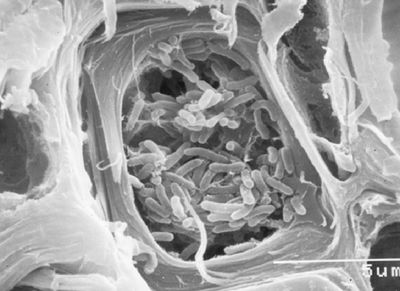
Photograph: José Lima
Xylella fastidiosa is a plant pathogenic bacterium first observed in 1884 on grapes, but it was only in 1987 that the bacterium got cultured and properly described in the USA. The list of host plants for Xylella fastidiosa currently comprises 563 plant species from the Americas, Europe, the Middle East, and Asia. In Europe 84 host plants have been identified.
Until today five subspecies of the bacterium have been described each affecting different host plants: Xylella fastidiosa subs. Fastidiosa (grape, alfalfa, almond, maple), subs.multiplex (peach, elm, plum, pigeon grape, sycamore and almond), susb.pauca (citrus, and probably coffee), subs.sandyi (Nerium Oleander, OLS) and subs.tashke (ornamental tree Chitalpa tashkentensis)4. Some host plants are affected by more than one subspecies. The subspecies affecting the olive groves of Apulia is the subs. Pauca.
Due to the large host range and vectors, it became ever harder to control the expansion of the disease in America5 which inevitably led to its arrival in Europe.
Transmission and Expansion
The bacterium is naturally transmitted by insect’s vector: spittlebug (sucking insects). They thrive in weeds during the spring, and through the dried weeds are driven up to the infected tree during summer/fall. Once infected with Xylella fastidiosa, insects remain infective with the pathogen. The bacterium becomes persistent in adult insects. Vectors that overwinter as eggs are considered less important in the dissemination of the disease. Therefore, Xylella fastidiosa was mostly present in sub-tropical/tropical climate of Southern America and California where the vector would survive more than one season, and spread the disease over the critical spring season6.
Over the 20th century, other than the American continent, one isolated case had been identified in Taiwan (1994) causing leaf scald in pear7. Though since 2013, the subspecies pauca (Xfp) is officially present in the European continent and is slowly moving towards the middle east. It was first detected in the area around Gallipoli, on the southern Ionic coast of Salento8 and has then also been confirmed in France (2015), Balnearic Islands (2016), Spain (2017) and Portugal (2019)9. Researchers presume that due to climate change, the temperature of the Mediterranean basin became mild enough over the winter for vectors to survive more than one season. Xylella was possibly already present in the European territory before 2013, but had simply not the ideal climate to expand properly10. Xylella fastidiosa is today a bacterium settled in the European territory.
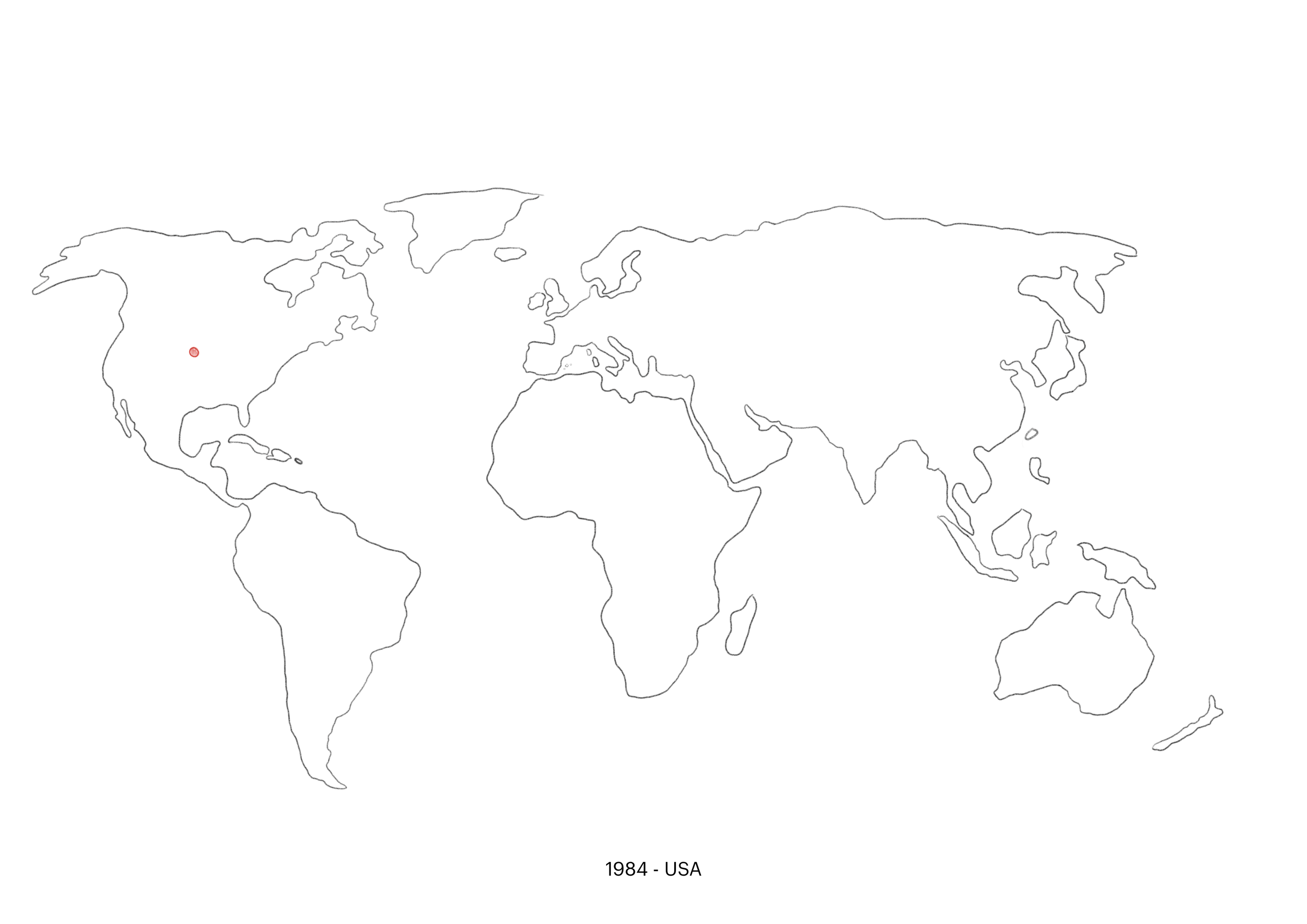
Source: EPPO Global Database
Symptoms
Early symptoms of Xylella fastidiosa on the infected plant are a slight bronzing of the tip or margin of the leaves; this intensifies over time before becoming brown. Once infected the xylem of the host plant gets obstructed, consequently there is no sufficient water flow anymore to feed the plant, which leads to its death. In the case of the Olive trees the bacterium leads to a disease called Olive Quick Decline Syndrome (OQDS)11.Those visual symptoms though do not always appear, many plants are defined asymptomatic hosts. A research of the late 90s demonstrated 3 out of 4 species of Grape and Alfalfa strains were classified as symptomless hosts depending on the vector transmission. The polymerase chain reaction (PCR test) is the best diagnostic method for an initial screening for plant materials in phytosanitary quarantine. But Xylella fastidiosa is a slow growing bacterium and the populations of the bacterium within a plant host varies greatly in the early stages of infection as well as seasonally within the plant itself. Therefore, the detection of the bacterium is sometimes very difficult and additional screening methods are needed. The cells of Xylella fastidiosa are small and narrow, only visible using a microscopy. By cutting root sections and immersing them in acidified methanol the disease can be identified: where vessels contain the bacteria, purplish spots will appear within a minute or two12. The difficulty of the identification of the infection at its early stage is the cause for the fast spread and dramatic territorial impact of this disease.
Prevention
Chemical curative control of the bacterium is not possible, so the focus is rather on accurate prevention methods. First the reduction of the vector population within the olive groves is essential to resist the disease expansion. This can be achieved through a better management of the grove: tilling, mowing of soil, regular pruning of trees, watering and maintenance or restoration of a good soil fertility. Second grafting the uninfected/semi-infected olives with a resistant variety. This consists of manually attaching a branch of a resistant variety on the trunk of the endangered plant. With time both trees will become one and be resistant to the bacterium. This process cannot be mechanized, it is labor intensive, consequently expensive and therefore mostly applied only on secular olive trees of cultural value. For olive groves of economical value the preferred solution is the replanting of a resistant variety, like Leccino or Favolosa. Those can only be planted in intensive monocultures that demand a heavy use of pesticides and chemical fertilizers. Thirdly a biological spray treatment for the maintenance of the healthy tree or the restoration of the partially diseased olives is being researched. This solution wouldn’t be particularly labor intensive or expensive13. However all current preventive methods are not at all questioning the spatial organization, the architecture, of the olive grove. There is a critical proximity of plants in monoculture plantations which is the cause for the fast expansion of the disease. The current situation has to be evaluated more radically, the problem lies deeper, the bacterium is not the only reason for the pandemic’s fast spread. Those preventive methods are like fighting a fire with gasoline, they do not prevent against other pandemic’s outbreaks and only encourage more. Indeed if those preventive methods are not consequently applied, the result is inevitably again a dramatic and uncontrolled expansion of the bacterium, leading to severe ecological and economic degradation.
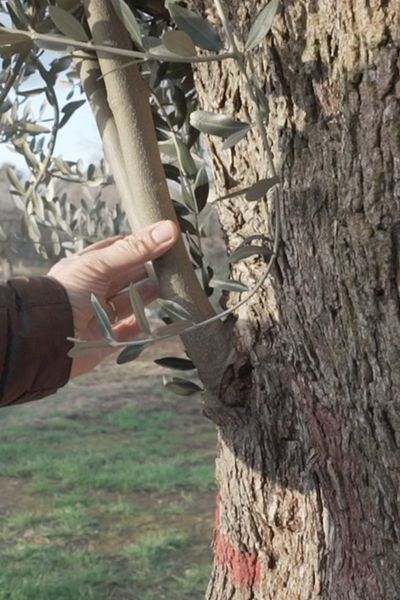
Photograph: savetheolives
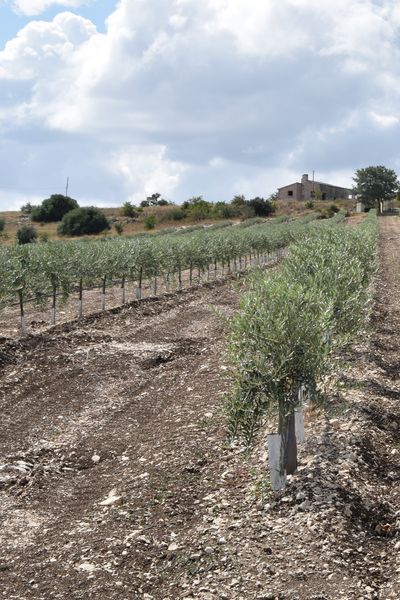
Photograph: Annamaria Bonzanigo

Photograph: Annamaria Bonzanigo
Economical and Territorial Impact
Since its first detection in the late 19th century in the USA, the variation of Xylella fastidiosa Pierce’s Disease (PD) on grapes has caused the decline of more than 35’000 acres of vineyards in Southern California14. In Brazil, first reported in São Paulo state in 1987, the variation Citrus variegated chlorosis (CVC) affected in 20 years more than 100 million sweet orange trees15. A report published in 2019, stipulates that Xylella fastidiosa led to a shrinkage of 9.5% of the Italian olive production16. Since its arrival in the tip of the heel of Italy, the bacterium has been expanding at a speed of 25km per year along the Italian Region of Apulia. Severe measures had to be taken to slow down the bacterium’s expansion rapidly reaching the northern provinces. This became strongly problematic because those are of strong economic interest: Bari, Barletta, Andria, Trani, represent 12% of the usable agricultural area of Italy’s olive groves and account for 28% of the national production17.

Source: Emergenza Xylella
Under the supervision of the European government, the whole region of Salento, southernmost part of Apulia is defined as an infected zone and two buffer zones have been created between Brindisi and Bari, where olives are fell to avoid the expansion of the bacterium18. Yet, remains the question, how long will this solution resist the virus’ expansion.

Photograph: Annamaria Bonzanigo

Source: Annamaria Bonzanigo
Talking with several farmers across Apulia, I realized that pursuing north the olive increasingly becomes a product of important economic value. The production is maximized as well as the narrative around the olives beautified for a touristic purpose.Therefore in those territories, preventive methods were radically and rapidly put into place. On the contrary in Salento, the olive farming seems to have been already in crisis before the arrival of Xylella fastidiosa. The value of the olives lies rather on a common unspoken idea of a cultural heritage. The expansion of the disease could have been stopped radically like in northern Apulia today, but no one seemed to be willing to invest enough money on that. Millenary olives were a palimpsest of a long history. Their remains and slow disappearance in the territory of Salento today is pointing out the conflict between the cultural and the economic value of our agricultural practices. To better illustrate this conflict we will further focus on Salento.
Salento—The Land of Burning Olives
Salento is situated on the southern end of the administrative region of Apulia in Southern Italy. It is a sub-peninsula surrounded by the Ionian and the Adriatic Sea. 41% of its extension is covered by olive groves19, meaning more than 11 million20 scattered olive trees define the landscape of this territory today. Most of the olives are situated in the inland, creating an urban forest21. In 2015, the national syndicate Italia Olivicola estimated the infection to almost 50% of the olive groves of the region22. It is highly presumed that through the transport of ornamental plants coming from central America, the bacterium was brought in an active nursery plant in Gallipoli and from there expanded throughout the territory. The bacterium was not contracted at its early stages and therefore the expansion became ever faster and harder to control.
The Fall of the Countryside
Olives have been cultivated in Salento since the Bronze Age due to the favourable climate23. During the Republican period Apulia became the main source of oil for Rome and its territory24. In the 8th century, Basilian Monks, who escaped from the Byzantine Empire, settled in Salento where they dedicated their time to olive cultivation. The practice of grafting wild olive trees with clonal locals and foreign cultivars was developed and many olive groves were framed with dried stone walls25. During the 16th/17th century the economy of the region started to strongly develop around olive cultivation and many olive trees were planted26.The trapetto was the space used for the storage and the working of the olives as well as for the preservation of the olive oil. The trapetto was mostly underground: there was a belief that the olives had to be kept in a warm place, for a long time before being pressed. Salento became the most important area to produce lamp oil, exporting all the way through until Russia27.
At the beginning of the 18th century, many olives of the species Ogliarola di Lecce were affected by the disease Brusca and were grafted with the variety Cellina di Nardò28. New methods for the grind of the olive were being claimed by economist, agronomist and traders. The trapetto was not leading to a good quality of oil and the foreign oils were becoming strong business rivals. But the work of the olives was imbibed into a strong feudal system, and barons had no interest in improving the work organisation on the land despite the increasing production.
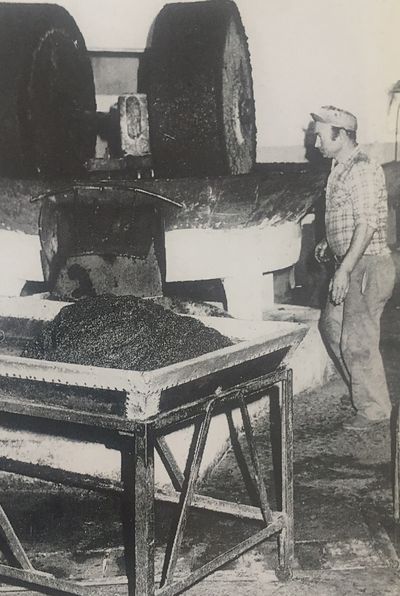
Photograph: Congedo Editore
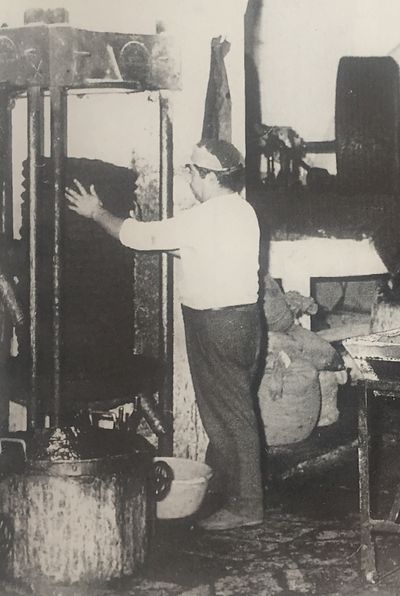
Photograph: Congedo Editore
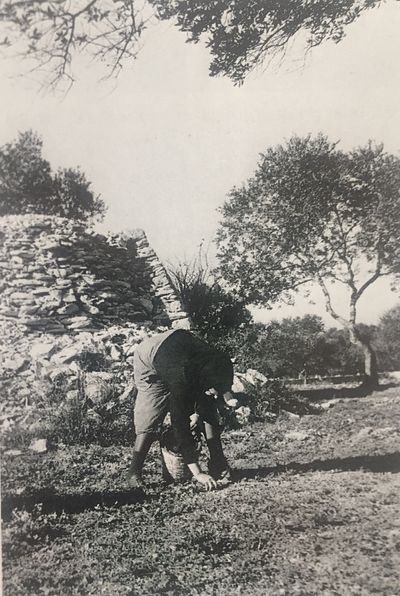
Photograph: Congedo Editore
The Rise of the Coast
The bad management, the backwardness of the cultivation techniques and the archaic systems of olive oil production led many peasants to abandon their land and find work abroad; in the long term, this led to the crisis of Olive cultivation in Salento29. Salentini abroad made the region more visible around the world increasing its attractivity as touristic destination.
Along the coast, the marshlands needed to be dried, too many people were dying of malaria, typhus. The few peasants left had to fight against the rocks and the marshlands for an agriculture of subsistence. At the turn of the 20th century the local government started drying the marshlands; this process was very much slowed down by the two world wars. The focus was put towards touristic development, rather than working on the socio-economic requalification of the countryside and enhance the possibility of rebuilding a land for cultivation along the coast. Villas were built which profited only the privileged.

Photograph: Congedo Editore
The development of the irrigation systems led to a transformation of the cultural practices along the coast. Rather than cereals and olives other types of cultivation emerged, such as floriculture and horticulture30. The economic activity switched from one of agricultural production to one of services and industry, oriented towards an international tourism. The inland became an attractive “natural” destination, a decorative backdrop, and the coast a territory of “second house”. But many olives, even though abandoned and silent, continued to contribute to the microclimate, the biodiversity and the social health of the region, strong symbol reminiscent of a long flourishing past31. The rise of the coast, led to the fall of the countryside. In a strive for international visibility and attractivity, the care for the land and the local has been lost. Xylella fastidiosa makes this loss now visible.
The Future of Olive Farming
Agricultural practices are imbibed in a cultural heritage which is nowadays being totally ignored for the sake of an increased production and monetary income. Xylella fastidiosa demonstrated that olive farming is in crisis and needs to urgently be rethought collaboratively between scientists, designers, policy makers, local communities, fauna and flora.
As we have shown in the first part of this essay, the resistant species we know today for Xylella fastidiosa can only be planted in intensive or super-intensive plantations. This wouldn’t solve the fast spread of an eventual new epidemic. In the second part, we have shown it is not the first time a disease hits the olives of Salento. Those are then grafted or replanted with resistant varieties, what in the long term is no viable solution. The focus today is on agricultural and biological solutions, focusing on olive farming and resistant species. I believe we should rather start to question the organisation of the territory. Is monoculture the best solution? Is industrial agriculture the way we want to go? Are we aware of the many pathogens that are travelling globally through the displacement of plants? Plant parasites may not affect us directly as COVID-19 does, but if we do not react urgently, we might soon find ourselves with wreaked havoc cultivations, and then the question will be how do we feed ourselves?
Since 2016, a new rule in Salento diminished the period of no change in land use from 15 to 7 years after the explant32. This urges us to rapidly find answers for the future of this territory. In 7 years, do we want to give way to property and soil speculations?
Unlike the olive plantations of northern Apulia, the olive orchards of Salento are a semi-natural construct of cultural, climatic, and ecological value.
The Climatic Value of Olives
In Salento along the Adriatic Coast used to exist territories considered peri-urban forests due to the density of planted olives. Those worked as natural air conditioner, reduced air, water, noise pollution and heat island. Their eradication is strongly impacting the public health of the inhabitants of the adjacent urban centres33.
The Cultural Value of Olives
Many of the dead olives in Salento were not a mere apparatus of agricultural production; with more than hundred years, ancient olives had a strong cultural value. On the territory today dried walls and ruins of stone huts remain as traces of a long history of care given to each single tree and grove.
The Ecological Value of Olives
Ancient olive orchards are the symbol of a high value farmland, a mosaic of semi-natural and cultivated areas34, an agro-ecosystem35. The intricated forms of the tree’s trunk and the diverse plants of the Mediterranean flora cultivated around them create a multiplicity of habitat for many vertebrate, and invertebrate fauna. This consequently ensures food to a large number of birds during the summer as well as during the winter season36. This service goes far beyond the national border, since the host birds migrate from the north of Europe37.
Some ancient infected olives today have a dead trunk but new branches of naturally grafted wild olives are already regrowing. The surrounding flora is using the structure of the dead trunk as a base to expand its growth. Nature is taking command.
To conclude, in Salento there is not only one type of olive, but many: the grafted olive, the infected olive, the dead olive, the regrowing olive, the eradicated olive, the felled olive, the healthy secular olive and the healthy olive intensive plantation. Each of those olives has a different, architecture, relation to its surroudings and role in the local ecosystems. Rather than asking ourselves how could the virus be cured or prevented with new technologies and an unversal solution, the question should rather be on how can we use territorial design to enhance the existing ecologies and prevent any further extensive pandemic’s expansions? How can we preserve the agro-ecosystems we have inherited? How can we prevent our soils from drying out? How can we sensitize our populations to appreciate a different kind of nature, less ordered, less productive, more chaotic and more beneficial to our ecologies?
Farmers in Spain are felling their secular olives, not being able to invest in grafting, fearing the arrival of the bacterium and recognizing a better earning in super-intensive plantations38. A small tree planted for production doesn’t benefit to carbon storage, water retention and microclimate regulation in the same way as a tree that was planted hundred of years ago39.
As I am writing this article, pine tortoise, is leading to the death of all the Ancient Rome’s pines40. Amidst a rapid displacement of plant parasites, it is now more urgent than ever before to recognise and preserve the semi-natural architectures we have inherited. ●
1 V.A., “WHO-convened Global Study of Origins of SARS-CoV-2: China Part”. In: WHO Joint Report, 14. January-10. February 2021, pp. 8-9
2 Brilliant, L., “The Age of Pandemics”. In: The Wall Street Journal, 2. May 2009
3 Tartaglini, N.; Calabrese, G.; Servadei, L., “A Multi-Scale and Multi-Level Approach for Conservation of Ancient Olive Orchards in the Euro-Mediterranean Region”. Mediterranean Agronomic Institute Bari, 2012, p.27
4 Janse, J.D; Obradovic, A., “Xylella Fastidiosa : Its Biology, Diagnosis, Control and Risks”. In: Journal of Plant Pathology, 92 (1 supplement), 2010, p.1.36
5 Purcell, A.H., “Xylella Fastidiosa, A Regional Problem or a Global Threat?”. In: Journal of Plant Pathology, Vol. No. 2, July 1997, pp. 99-105
6 See footnote 4, pp. 1.36-38
7 Leu, L.S.; Su C.C., “Isolation, cultivation, and pathogenicity of Xylella fastidiosa, the causal bacterium of pear leaf scald in Taiwan.”, In: Plant Disease 77, 1993, pp. 642-647
8 Various Authors, “Impact of Xylella Fastidiosa subspecies pauca in European olives”. In: PNAS, Vol.117, no.17, 28. April 2020, pp. 9259-9259
9 European Commission, “Latest Developments of Xylella Fastidiosa in the EU territory”.
https://ec.europa.eu/food/plant/plant_health_biosecurity/legislation/emergency_measures/xylella-fastidiosa/latest-developments_en (retrieved on 25. May 2021)
10 See footnote 4, pp. 1.40-42
11 Various Authors, “Xylella Fastidiosa in Olive in Apulia: Where we stand”. In: Phytopathology Review 109, 2018, pp. 175-186
12 See footnote 4, pp. 1.39-40
13 Scortichini, Marco “The multi-millenial Agro-ecosystem of Salento (Apulia, Italy) Threatened by Xylella Fastidiosa Subsp. Pauca : A Working possibility for restauration” In : MDPI Journal Sustainability, 2020, pp. 9-11
14 V.A., “Pierce’s Disease of Grapevine: A Review of Control Strategies and an Outline of an Epidemiological Model”., In: frontiers in Microbiology Vol.9 Art. 2141, 2018, pp.1-2
15 V.A., “Citrus Variegated Chlorosis: An Overview of 30 Years of Research a disease Management”. In: Tropical Plant Pathology, 2020
16 V.A., “Proposta per un piano Straordinario di Riconversione e di Ristrutturazione degli Oliveti Salentini”, In: Italia Olivicola Consorzio Nazionale, Rome, February 2019, pp.1-6
17 “Gli Interventi per il contrasto del batterio della Xylella Fastidiosa”. In: Camera dei deputati Servizio Studi XVIII Legislatura, 28. April 2021
18 See footnote 9
19 V.A., “Change in Olive Urban Forest Infected by Xylella fastidiosa: Impact on Microclimate and Social Health”. In: International Journal of Environmental Research and Public Health, 2019, p.3
20 See footnote 13, pp. 3-5
21 See footnote 19, pp.1-3
22 “Xylella, lo studio : 4 milioni di alberi morti e improduttivi, 50 mila ettari desertificati, perso il 10% dell’olio italiano”, In : Italia Olivicola Consorzio Nazionale, 28. February 2019, https://www.italiaolivicola.it/news/comunicati-stampa/xylella-lo-studio-4-milioni-di-alberi-morti-e-improduttivi-50mila-ettari-desertificati-perso-il-10-dellolio-italiano/ (retrieved on 25. May 2021)
23 V.A., “Environment, crops and harvesting strategies during the II millennium B.C.: Resilience and adaptation in socio-economic systems of Bronze Age in Apulia (SE Italy)”. In: Quaternary International 436, 2017 pp. 83-95.
24 Cortonesi, A. , “L’olivo nell’Italia medievale”. In: Reti Medievali Rivista VI (luglio-dicembre), 2005, pp. 1-2
25 See footnote 24, p.9
26 Constantini, A., “Guida ai Monumenti dell’Architettura Contadina del Salento”. Congedo editori, 1996, p.125
27 Donno, G. “Gli olivi Salentina e Calabrica secondo G. Presta e C. Moschettini”. Instituto di Coltivazion Arboree, Bari University, 1973, p.10-15
28 See footnote 27, p. 23
29 See footnote 26, pp. 125-147
32 Piemonte, S.; Emiliano, M., “Deliberazione della Giunta Regionale 7 ottobre 2019, n. 1780” In : Bolletino Ufficila della Regione Puglia – n. 121, 22. October 2019
33 See footnote 19, pp. 13-18
34 See footnote 3, pp. 29-30
35 Niethammer G., «Vogelwelt Kretas im Winter. Anzeiger der Ornithologischen Gesellschaft». In: Bayeres 7 (Sonderheft), 1966, pp. 726–731
36 Guzman Alvarez J. R., “Olive cultivation and ecology: The situation in Spain”. In: Olivae 78, 1999, pp. 41-49.
37 See footnote 3, pp. 29-31
38 Kassam, A., “Century-Old olive trees felled as Spain’s farmers try to cut cost”. In: The Guardian, 12. March 2021
39 V.A., “The Ancient Tree Inventory: a summary of the results of a 15 year citizen science project recording ancient, veteran and notable trees across the UK”. In: Biodiversity and Conservation 29, 2020, pp.3106-3107
40 Giuffrida, A., “50’000 set aside to same Rome’s pine trees from deadly parasite”. In: The Guardian, 15. April 2021
30 See footnote 26, p. 177
31 See footnote 19, pp. 18-19
